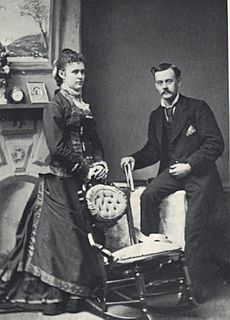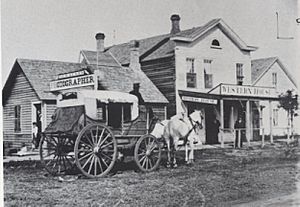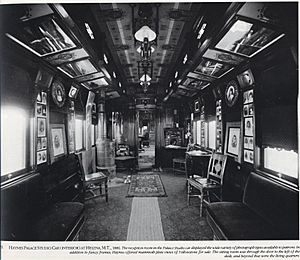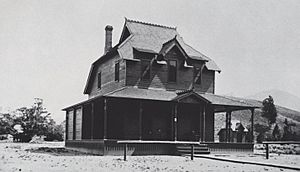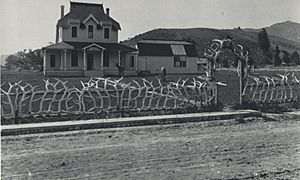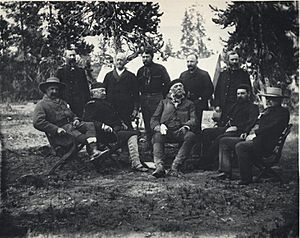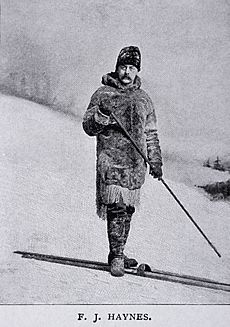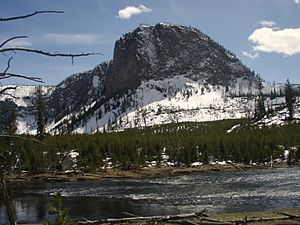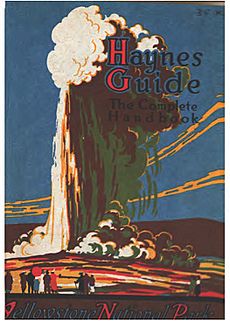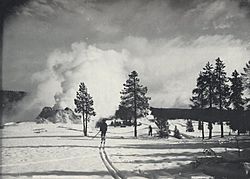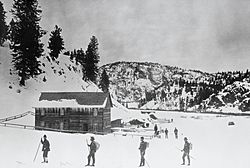Frank Jay Haynes facts for kids
Frank Jay Haynes (born October 28, 1853 – died March 10, 1921) was a famous photographer, publisher, and businessman from Minnesota. People often called him F. Jay or the Professor. He played a huge part in taking pictures of the American Northwest as it was being settled.
F. Jay Haynes became the official photographer for the Northern Pacific Railway and Yellowstone National Park. He also ran early travel services inside Yellowstone. His photos were used in many articles, books, and became popular stereographs (3D pictures) and postcards in the late 1800s and early 1900s.
Contents
Early Life and Photography Beginnings
F. Jay was born in Saline, Michigan, on October 28, 1853. His family moved to Detroit, Michigan, when he was a small boy. F. Jay worked in his father's store and did other odd jobs.
He became interested in photography after visiting a photo studio in Detroit. Later, he moved to Ripon, Wisconsin, and started working as an apprentice at the Doctor William H. Lockwood's Temple of Photography. He learned how to be a photographer there and met his future wife, Lily Snyder.
In September 1876, F. Jay opened his own photography business in Moorhead, Minnesota. His brother-in-law, Gus Henderson, helped him get started.
Family Life and Business Growth
In Moorhead, F. Jay began his long and successful connection with the Northern Pacific Railway. His business was doing very well. In January 1878, he married Lily Snyder and brought her to Moorhead to help with the studio.
They had a daughter, Bessie Loa, and two sons, George and Jack Ellis. Their son, Jack Ellis Haynes (1884–1962), took over his father's business in Yellowstone in 1916. He continued to be the official park photographer until he passed away in 1962.
Haynes Photography Studios
Moorhead, Minnesota Studio
The first Haynes Studio opened in Moorhead, Minnesota, in December 1876. From this studio, F. Jay grew his railroad photography business. He also sold local portraits and views of his railroad photos.
By early 1879, F. Jay moved his Moorhead studio to a much bigger place. However, in the fall of 1879, he closed it and moved west across the Red River to Fargo, North Dakota.
Fargo, North Dakota Studio
F. Jay lived and worked in Fargo until 1889.
St. Paul, Minnesota Studio
In 1889, F. Jay opened his final studio in St. Paul, Minnesota.
Haynes Palace Studio Car
In 1885, F. Jay bought a special train car from the Northern Pacific Railroad. He had it turned into a photography studio on wheels! The railroad charged him a small fee to move the car around their railway system.
By 1901, the fee was about 35 cents per mile. In return, F. Jay gave the railroad some free photos of their trains and buildings for advertising. When the Palace Studio Car visited a town, F. Jay or his team would take pictures for local people. They would then deliver the prints on later visits. F. Jay used this unique studio car successfully from 1885 to 1905.
Official Photographer for the Northern Pacific Railroad
Soon after moving to Moorhead, Minnesota, in 1876, F. Jay started working for the Northern Pacific Railway. The railway was expanding west, and they needed photos. By October 1876, he had a contract with them for the next year.
His job was to take photos for publicity and create 3D views of trains, stations, sights along the railway, and construction from St. Paul, Minnesota, to Bismarck, North Dakota. F. Jay was a smart businessman. He agreed to give the railroad a certain number of prints from each photo. But he kept the rights to the original photos, so he could print and sell more for himself.
The railroad also gave F. Jay a free pass to ride all their trains. This allowed him to travel anywhere on the railway and photograph whatever he wanted. His "Northern Pacific Views" and local portraits were very popular, and he could barely keep up with the demand.
In 1879, F. Jay met Charles S. Fee, who worked for the railroad's General Manager. In 1883, Fee became the railroad's main marketing person. He held this job until 1904. Fee became F. Jay's biggest supporter within the railroad, and they became lifelong friends.
Official Photographer and Business Owner in Yellowstone National Park
In 1877, F. Jay met Philetus Norris, who was the superintendent of Yellowstone National Park. Norris encouraged F. Jay to visit the park and photograph its amazing sights. Because of his railroad work, F. Jay couldn't make the trip until 1881. By then, Northern Pacific Railroad tracks had reached Glendive, Montana.
Even before visiting the park, F. Jay's business sense led him to apply to the government to become the Official Photographer of Yellowstone National Park. He didn't get that exact title at first. But with Norris's help, he was allowed to open a small photo studio inside the park. This was made official in 1884.
In September 1881, F. Jay made his first trip to Yellowstone National Park. He traveled overland from Glendive, with support from Charles Fee. In almost two months in the park, he visited all the main attractions and took over 200 photos. F. Jay returned to Yellowstone every year after that first visit until he passed away in 1921.
President Chester A. Arthur's Trip to Yellowstone (1883)
In May 1883, President Chester A. Arthur needed a good rest from his busy presidency. One of his advisors suggested a trip to the new national park, Yellowstone. The trip was planned for two weeks in August. President Arthur would visit the park without any journalists.
Because F. Jay Haynes was already famous for his railroad work and early trips to Yellowstone, he was chosen as the official photographer for the President's trip.
1887 Winter Adventure
In December 1886, F. Jay was chosen to go on a winter tour through Yellowstone Park with arctic explorer Frederick Schwatka. A newspaper and a magazine sponsored this trip. The adventure began at Mammoth on January 5, 1887.
Schwatka, Haynes, and eleven guides traveled on skis and snowshoes, pulling sleds full of gear. They went from Mammoth to Norris in two days. But by the time they reached Norris, it was too cold and difficult for Schwatka, and he had to leave the tour.
Haynes and three guides he trusted decided to continue the trip. They visited the lower and upper geyser basins and Yellowstone Falls. But then they ran into trouble. While trying to reach Yancey's from Canyon, the group got stuck for 72 hours on the slopes of Mount Washburn. They were in a freezing snowstorm with little food or shelter and were in great danger.
Once the weather cleared, they made their way to Yancey's to recover before returning to Mammoth. The 29-day tour covered almost 200 miles through a very cold winter environment. Temperatures ranged from about -23°C (-10°F) to -47°C (-52°F). Despite the problems on Mount Washburn, Haynes returned with 42 photos of Yellowstone in the middle of winter. These were the first photos ever taken of the park during that time of year!
Memorials to F. Jay Haynes
When F. Jay passed away in 1921, Horace Albright, who was the superintendent of Yellowstone National Park, officially named a mountain in the park Mount Haynes 44°37′58″N 110°56′46″W / 44.63278°N 110.94611°W.
Albright also had a large granite rock from the Golden Gate area of Yellowstone shipped to St. Paul, Minnesota, to be placed on F. Jay's grave. Many of F. Jay Haynes' original photographs are now very valuable collector's items. His large prints of the Yellowstone region are especially sought after and can be worth a lot of money today.
Works Published by F. Jay Haynes
- The Haynes Guide was a popular book published every year until 1966. F. Jay Haynes started it, and then his son Jack Ellis Haynes continued it.
- Notable images by F. Jay Haynes
-
Lower Yellowstone Falls, January 1887
-
Castle Geyser, January 1887
-
Excelsior Geyser (1888 photo), only known photo of this geyser erupting.



